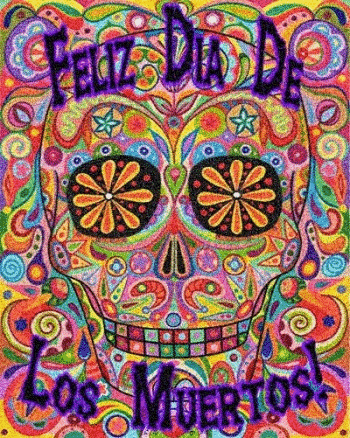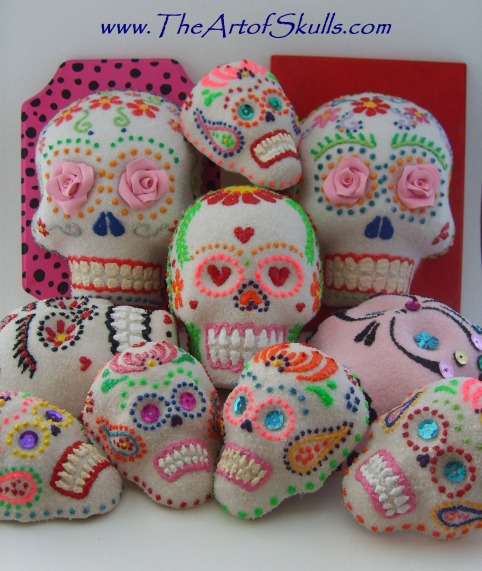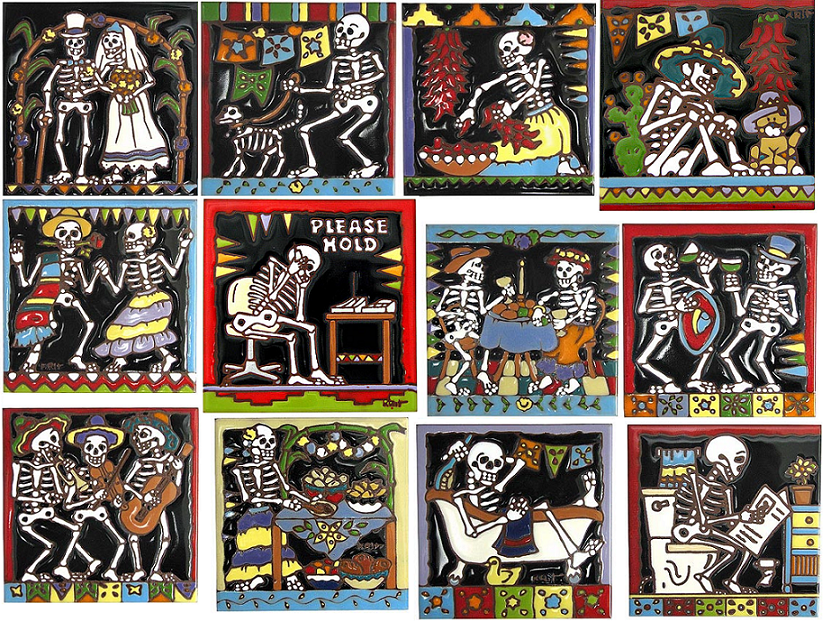Day of the Dead.
About The Holiday.
A holiday of celebrating and respecting people's loved one's who have moved on to the other side.
November 1st and 2nd, (in mexico and other countries too.) They believe that it is easier for the souls of the departed to visit the living world.
They clean up graves, decorate them and put orange marigolds around the graves as an offering.
In most regions of Mexico, November 1st honors deceased children and infants where as deceased adults are honored on November 2nd.
This is indicated by generally referring to November 1st as "Día de los Angelitos" (Day of the Little Angels) and November 2nd as "Día de los Difuntos" (Day of the Dead)
Some Traditions include building private altars honoring the deceased, and using sugar skulls, marigolds, and the favorite foods and beverages of the departed.
People will go to cemeteries to communicate with the souls of the departed, and will build private altars, containing the favorite foods and beverages, and photos and memorabilia, of the departed.
The intent is to encourage visits by the souls, so that the souls will hear the prayers and the comments of the living directed to them. Some people believe that possessing "dia de los muertos" items can bring good luck.
Many people get tattoos or have dolls of the dead to carry with them. They also clean their houses and prepare the favorite dishes of their deceased loved ones to place upon an altar.
Even though it is sad that they're loved ones have passed on they do not cry, as the elders say that the path back to the living world must not be made slippery by tears.
It is said that you will see the Devil, too, as he plays and frolics with the Skeleton. He came to the holiday from the Catholics, who tell us to be saintly or be banished to Hell or Purgatory. (Kinda Scary don't you think?)
They say that The Dead are full of Life and we see it in many things such as statues, toys, and little trinkets from the day of the dead.
It is said that the dead speak to us by strange things happening(I.E. high flames in candles before they go out, glasses of water tipping over, etc. etc.)They want you( not REALLY YOU, but people in general) to not forget them.
They (the dead) Love us and want us to remember them, just as you would want your loved ones to remember you when you have passed on.
Even though the day of the dead sounds like a dreary name for a holiday, it is a very happy holiday actually.
If you look at the figurines they are almost always smiling.Sugar skulls are a very popular treat for the day of the dead.
They range in size from a few inches tall to life size.
They celebrate with various items and such like Paper mache skulls bear pink flowers for eyes and green lizards on their brows.
Wooden skeletons on rods dance wildly, with arms and legs flailing, whenever you pull their string.
The calaveras sing, dance, laugh, they even ride on merry-go-rounds and drive rickety wooden trucks.
They also drink pulque, a fermented drink this is made from cactus.
They make pan de muerto (the bread of the dead...its rymths) is a sweet bread that is baked for the dead and helps them on there way to the "next level".
A Dia de los Muertos (Day of the Dead) altar is meant to honor the memory of someone who touched your life. This can be anyone from the family pet to Mother Teresa. Anyone who had a positive impact on your life can be the subject of your Day of the Dead altar.
Some Translations are:
alfenique - a special confection used to fashion skulls, fruits and other figures.
altar de muertos - the offering that family and/or friends prepare for their dead loved ones
angelitos - the souls of the children who have died, literally "little angels"advertisement
arco - decorated arch sometimes placed on the graves or on the altar de muertos
atole - an ancient drink made from corn meal and water flavored with various fruits.
calacas - whimsical skeleton figures that represent death
calavera - a skull, also a slang term for "daredevil"
calaveras - songs and poems about the festival
calaveritas de azúcar - sugar skulls made for the Día de los Muertos
careta - mask worn by dancers to scare the dead away at the end of the celebrations
catrina - Famed Día de los Muertos artist José Guadalupe Posada's icon of death. Catrina means: a wealthy woman, it is said in a sarcastic manner.
cempazuchitl - a yellow marigold, the symbol of death, also known as Cempasuchil or zempasuchitl
copalli - a scented resin used to make incense
Día de los Muertos - Day of the Dead
Día Todos los Santos - All Saints' Day
golletes - A doughnut shaped bread, glazed with pink colored sugar that is placed on the altar.
Iluminación - The ceremony that takes place in the cemetary, where hundreds of candles are lighted to guide the souls to their altars.
mole - a thick sauce made from a variety of ingredients including chilis, sesame seeds, herbs, spices, chocolate/fruit.
ofrenda - an offering, refers to the goods set out on the altars
pan de los muertos - bread of the dead
papel picado - colorful tissue paper with intricate, festive designs cut outMuerte - Death
cráneos de azúcar - Sugar skulls
Celebración – Celebration
Pan – Bread
Decoraciones – Decorations
Significado espiritual - Spiritual Significance
Cementerios – cemeteries
Cultura – Culture



